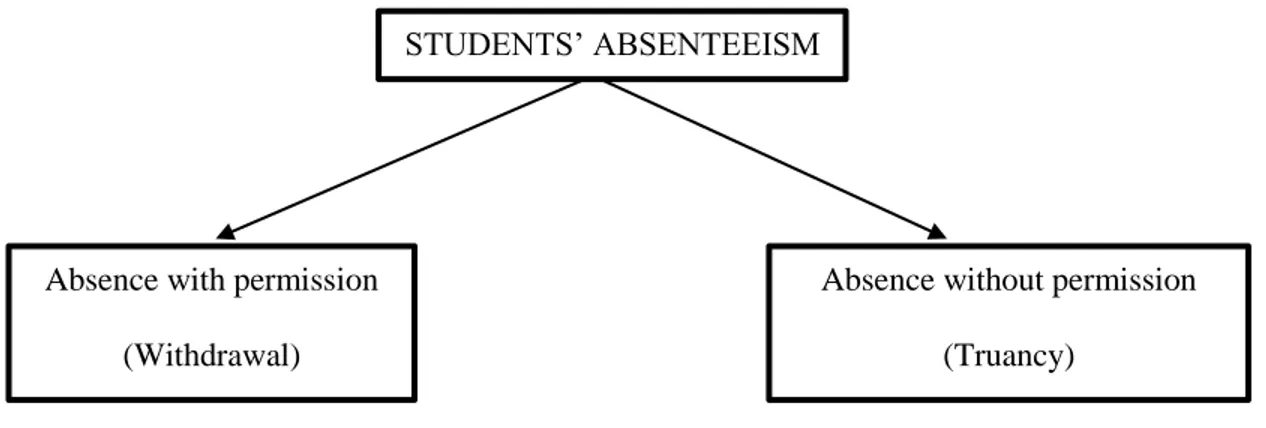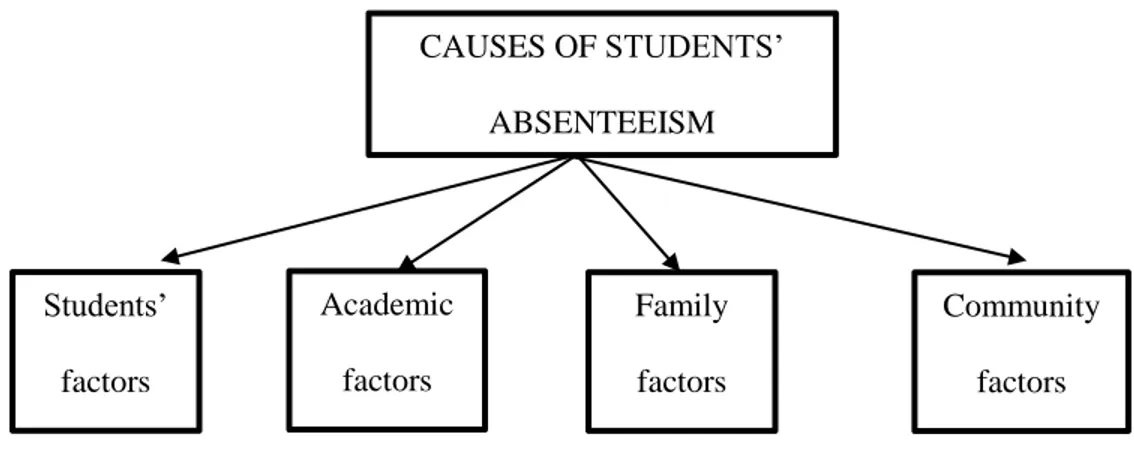Chapter Two Literature Review
This chapter describes the literature review and the conceptual framework that are used in this research. In the first sub chapter, the researcher clarifies the review of the literature on
certain points. The first section of this review discuss students’ absenteeism. The next discussion is to discuss about the institution policy on minimum attendance followed by the kinds of
students’ absenteeism. The following section is to identify the literature on the causes of
absenteeism. Another part of this chapter is going to address the conceptual framework that will guide this research.
Students’ Absenteeism
Teixeira (2013) explained that “students’ absenteeism is generally defined as deliberate or habitual absence from the class without valid reason, excluding sickness or accidents” (p.2).
Moreover, Teasley (2004) explained that students’ absenteeism as a period of time when a
student does not attend the class. According to the explanation eaerlier, the definition of students’ absenteeism is a condition when the student do not attend the class because of some
reasons.
Students’ absenteeism happens because students have less of motivation in learning. This
reason could trigger students not to be present to the class. Some researchers argued that
students’ attitude and motivation for learning was a key factor in student absenteeism (Kottasz,
argued that students’ attitude towards teacher playsimportant role in students’ absenteeism
(Adıgüzel & Karadaş, 2013; Attwood & Croll, 2006; Gökyer, 2012; Pehlivan, 2006;
Veenstra, Lindenberg, Tinga, & Ormel, 2010; Wilkins, 2008). This matter shows that low motivation of students to attend the class could increase bad impacts to academic progress of the students. It would be different for students who attend the class regularly. The students who attend the class regularly will get higher academic progress because they follow all of the lessons and tests. The students who have followed all lessons in class have lot of preparations and
knowledge for doing test. This reason makes the students get a higher score in a test rather than the absent students.
Besides, there is another impact of students’absenteeism which is “students’ absenteeism could guide the teachers plan in the classroom and motivates other students in that class to absent at the same time” (Thornton, Darmody & McCoy, 2013, p.488). As an example of the
explanation earlier, the teacher have made a teaching plan using group discussion. In the teaching plan, the teacher will divide the students into some of group discussion. However, it could not be happen because some of students are not to be present to the class. In this case, the teacher have to change the teaching technique in their plan to be applied in teaching learning process. Furthermore, students’ absenteeism could also disrupt students’ learning, not only for
the absent student but also for the entire students in the class. In this case, the students who often absent from the class could trigger other students to absent at the similar time. It means, they can influence motivated students to do the same thing.
Institution Policy on Minimum Attendance
at the class is four meetings in total sixteen meetings. It means that, the minimum attendance is twelve meetings or 75% attendance in a semester. This contract is explained by the teacher on the syllabus or in the first meeting. If the student did not attend the class more than four times or higher than 75%, the student would get failed score. The failed score at English Education Department of UMY is D. It indicates that if the student has the failed score, the student will get the penalty or did not pass the course. It means that, the student have to retake the course on following semester.
Kinds of Students’ Absenteeism
As stated by Komakech and Osuu (2014) that students’ absenteeism is classified into two
classes which are absence with permission and absence without permission. Students’
absenteeism with permission commonly known as truancy. Meanwhile, students’ absenteeism
without permission commonly known as withdrawal.
Truancy commonly talks about unexcused, unpermitted, and uncommunicative absences. Absenteeism relates to lack of parental knowledge about the behavior, criminal behavior or academic issues, or social situations such as homelessness or poorness (Fremont, 2003). Besides, truancy identically with social situation of the student for the example is poverty. Poverty
problem influences student not to be present to the class because the students are not able to pay their tuition and buy some books.
The next discussion is to explain about withdrawal. In this case, students are not present to their class because their parents ask them to not attend the class. In this case, parents’
necessities and importance becomes the common root of students’ absenteeism. In line with
Cunningham (2005), the researcher mentioned that withdrawal as absence with approval from their parents. The last expert, Bond (2004) stated that the student could absent only be permitted by the teacher and their teacher gives them a reasonable excuse. The explanations from those statements are the reason why the student excuses from their class because of their parents necessities and priorities. In this case, the students are not present to their class because the student has another importance with their family in that day.
Causes of Students’ Absenteeism
This review of the literature centers on the causes of students’ absenteeism was conferred under certain categories. Etsey (2005) stated the causes of students’ absenteeism could be
categorized into four. They are family reason, academic reason, community reason, and personal characteristic of the student.
shopping, attend their family wedding party, or attend funereal ceremony. These reasons on the explanation above are in line with Thornton, Darmody, & Mc Coy (2013) who stated that sometimes Irish family are not ask their children to go to the class because they want to go holiday.
The following cause of students’ absenteeism is academic reason. This reason involves
the teacher, university administrator or even the atmosphere in the class. In their research, Shute and Cooper (2015) stated that students attend to the class but they left some activities during the meeting or left whole meeting. Moreover, Pehlivan (2006) found that the reasons given by students for non-attendance at lecture were bored at the class, dislike of lessons, encouragement of friends, and lack of expectations about education. Both of researchers explained that the finding shows that liking the teacher and their subject also has importance to the students motivation to attend the classroom.
Bad atmosphere of the university and the class could also become the cause of students to absent the class. This matter could be happen because of less number of supporting facilities in the class, limitation of books in library, and the internet connection. The level of students’ satisfaction of their university system and facilities could increase their motivation to not attend the class (Gomleksiz & Ozdas, 2013). This statement is in line with the statement from Aküzüm, Tan, Yavaş, & Uçar (2014) that the condition of being dissatisfaction of facilities also becomes the cause of students’ absenteeism.
from another absent student could be affect student to be absent from their class (Altınkurt, 2008).
The last discussion is the cause of students’ absenteeism because of students’ personal
reason. In this case, students are absent from their class because of several reasons. Health problem could be the biggest cause of students’ absenteeism (Yıldız & Kula, 2012). Sometimes students' health problem makes the student absent from their classroom. Moreover, Teasley (2006) noted some factors that contribute to student absenteeism such as family health, low income, transportation problems, and community attitudes towards education. Another cause is, the distance from students' home to their university and bad condition of the (Ozbas, 2010). In this case, students could not attend the class because of the difficulty to access their university, the limitation number of transportation, and bad condition of the weather such as rain and earthquake.
Lastly, the researcher concludes that the student do not present to the class with a lot kind of causes. The causes of students’ absenteeism in this review of the literature are for the reason that students' family, academic reason, community reason and the last is for the reason that personal reason of the student.
Conceptual Framework
Students’ absenteeism happens because the student has low motivation in learning.
According to Teixeira (2013) explained that “students’ absenteeism is generally defined as deliberate or habitual absence from the class without valid reason, excluding sickness or accidents” (p.2). Students’ absenteeism is divided into two classification. They are students’
absenteeism with permission commonly known as truancy. Meanwhile, students’ absenteeism without permission commonly known as withdrawal.
Furthermore, there are some causes that trigger students’ absenteeism. As stated by Etsey
(2005) the causes of students’ absenteeism could be categorized into four. They are family
reason, academic reason, community reason, and personal characteristic of the student. Family reason is an absence because the students go for vacation, shopping, attend their family wedding party, or attend funereal ceremony. Meanwhile, academic reason involves the teacher, university administrator or even the atmosphere in the class as the reason for students to not attend the class. Moreover, community reason is the students’ reason to not attend the class because of the
relationship between another student. Last, the student not attend the class because of their personal reason which is illness.
Figure 1. Students’ absenteeism divided into two, they are absence with permission and absence without permission (Komakech and Osuu, 2014).
STUDENTS’ ABSENTEEISM
Absence with permission
(Withdrawal)
Absence without permission
Figure 2. Cause of students’ absenteeism categorized into six. They are students’ factors, academic factors, family factors, and community factors.
Students’
factors
Family
factors Academic
factors
Community
factors
CAUSES OF STUDENTS’

